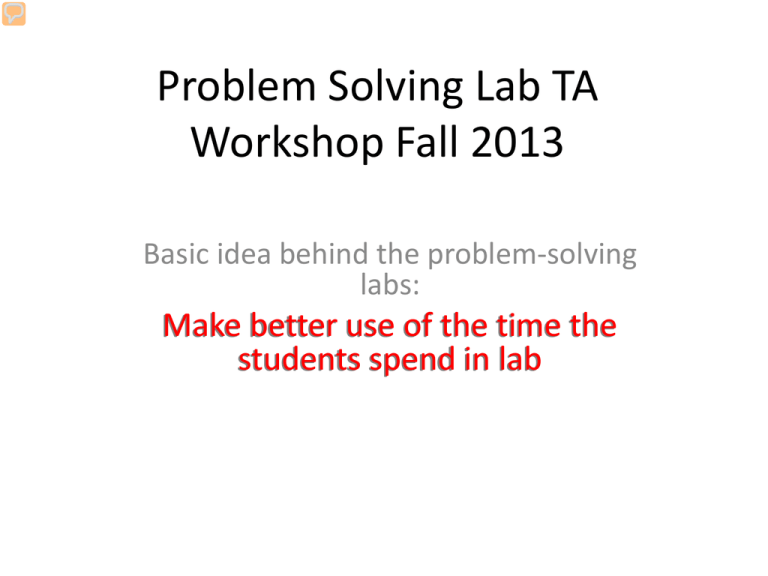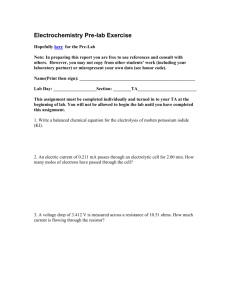Problem Solving Lab TA Workshop Fall 2013 students spend in lab
advertisement

Problem Solving Lab TA Workshop Fall 2013 Basic idea behind the problem-solving labs: Make better use of the time the students spend in lab What happens in lab? What do the TAs do? Part I: Entering Lab • Before lab, the TA checks the equipment etc. (5 minutes) • Students have reading and written pre-lab assignments. • The pre-lab needs to be checked when students enter lab. Will we check written work? Will we give a quiz? What if a student doesn’t do the pre-lab? What happens in lab? What do the TAs do? Part II: Synchronized In-Class Activity • In the lab, students work together in pre assigned groups with definite assigned roles. Group problem solving. • At the start, groups work together on short answer questions provided by the TA. (a) method (b) prediction What happens in lab? What do the TAs do? Part III: Asynchronous Experimental Activity • They should spend some time messing around with equipment. • The TA should not • Lecture on the class material involved • Write relevant formulas on the board • Commiserate with the students What happens in lab? What do the TAs do? Part III: Asynchronous Experimental Activity (Continued) • The TA should reinforce roles within the groups. • The TA provide help when equipment malfunctions. • The TA should not answer “what are we supposed to do?” type questions directly, rather should ask leading questions. Get students to respond and the groups to interact with each other. Checking lab equipment and computers before lab • This can take a while. Unfortunately, the lab periods can be close together. Arrive at least five minutes early. • Check what? Computers work, software runs, sensors work, oscilloscopes work, etc. • What to do when some piece of equipment doesn’t work? (a) First try to find Mizuho. (b) If not available, break down a group and reassign to groups with working equipment. • Always report equipment problems to Mizuho, in person or in writing. Student Pre-Lab Assignments • Students come to lab having read specific material assigned from the textbook. This is required. So, don’t provide this material in lab. Don’t let them copy each other. • There are also written questions, partly for purpose of checking reading. You will need a system to check this before lab. • Students who have not done pre-labs do not get into the lab. You must not make exceptions. • Problem: Students must do all labs to pass the course. Checking Pre-Lab Homework • Best method would be to quiz. Must prepare/grade parallel quizzes What about when students flunk totally? • But usually, we check the written work as students enter. Sit at front and check as they come in. Don’t facilitate copying or accept bullshit. Develop coded marks for pre-lab quality 1,2,3 • Later the pre-lab questions will count for grades. Student Work Groups • No more than 4 to group, preferably 3. • First lab meeting: Decide how many groups, not more than six, say “Count off, 1,2,3,4,5,6,1,2,3,4,5,6,1,2…… • All 1s go to first table, 2s to second table etc. Make a list of group members. • The groups are permanent until ½ semester, then we will reassign groups. Student Roles Within the ProblemSolving Groups • Task-Master. Keeps the group on topic and on schedule. Doesn’t permit chatting or spending too much time on part of a task. • Recorder. Organizes and does the data recording. • Skeptic (one or two per group) Tries to see what the group might be doing wrong— misunderstanding or making systematic errors. • Reporter (Shifts around, chosen each time.) Writes on white board and reports to the class. Time Spent in Lab 1. TA checks (5 min before). 2. Students enter, TA checks pre-labs. 3. Synchronized question and answers. Groups work as teams. Between questions, Reporter reports answers to class when requested. 4. Mostly Asynchronous, the groups work through the assigned measurement problems as the TA visits. Save time for the summary discussion. (Most of the period) 5. Summary discussion. Groups consider summary problems and report to/ discuss with other groups. 6. Finally, TA checks, in-class work, measurement plans and data and signs as students leave. Synchronized Work on Short Answer, Method and Prediction Questions • TA has selected several questions in advance. • Questions are either: – Method, having to do with how or what to measure, or – Prediction, where groups work out a theoretical answer as in normal physics problems. • A question is assigned, and a time limit given. • Groups must discuss. Recorder writes on white board and when called upon, presents to class. • Next question. (Not more than 20 minutes) Exploring the Equipment • Before starting measurements, the students must take time to explore the apparatus. • Often the TA will need to give a short talk on various aspects of how the set-up works. (DON’T give step-bystep instructions for the actual measurements.) • Sometimes additional material is provided. Students are supposed to have read the labs before coming to class. • Practically though, don’t count on this. Be sure each group can get started making measurements. Sometimes the TA will make a quick comment to help out, but don’t baby the students. Instruct by asking leading questions. Getting the Attention of the Class • Before you begin explaining or announcing something from the front of the room, learn to get the attention of the class. • Don’t start talking in a monotonous voice while some groups are ignoring you and carrying on a separate conversation. • Say, “Listen up, over there!” or something. Don’t start talking until you have their attention. Socratic Method for the TAs • Usually, you do not simply tell students what to do or how to solve a problem. • Instead, you lead the students to the answer in short steps by asking them questions in return. • This is called the Socratic method, and it is an important teaching method. • Be sure to get all members of a group involved in this activity, don’t let some of them ignore it. TA DOs AND DON’Ts • Don’t do extensive lecturing at the front of the room. • Don’t write necessary formulas on the board for the students. (Draw it out of them through individual discussion and coaching. Get other students to help.) • Don’t give them straight forward answers to “what should we do” type questions. Use Socratic method. • Don’t commiserate. That means, don’t encourage their griping. Don’t act as if you’re on their side and the stupid lecturer or lab coordinator is making you have them do stupid stuff, and so on. This is unethical and very bad. It undermines the whole enterprise of teaching and learning. DON’T DO IT. Understand that you are with the teachers not with the students, in this regard. Measurement Problems (The main course) • In the weekly meeting, we will agree on some of the measurement problems to do in each lab. These will take a lot of time and effort. • When you assign problems, remind the students of the time limit. (Save last 5 min.) • TA will circulate amongst the groups, and the TA asks questions. Sometimes coach. • See that all group members are participating. • See that students know their group roles. In the last 5 or 10 minutes • There will be a summary discussion. Discussion means the students themselves are supposed to be doing the talking, as much as possible. • Give one or two summary discussion questions based on the objectives of the lab. • Students use white boards. The group reporters stand and report to the class. • Finally, the TA checks students out. Recap 1. TA checks (5 min before). The End 2. Students enter, TA checks pre-labs. 3. Synchronized question and answers. Groups work as teams. Between questions, Reporter reports answers to class when requested. 4. Mostly Asynchronous, the groups work through the assigned measurement problems as the TA visits. Save time for the summary discussion. (Most of the period) 5. Summary discussion. Groups consider summary problems and report to/ discuss with other groups. 6. Finally, TA checks, in-class work, measurement plans and data and signs as students leave.





